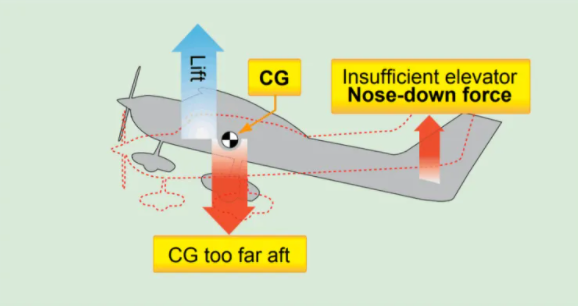Weight:
The weight multiplied with the acceleration due to gravity is what creates the force opposing the lift of the aircraft. One way that weight differs from the other forces acting on an aircraft during flight is that it is a field force, meaning the source of the force does not come in physical contact with the aircraft to create a push or pull. The other forces, thrust, drag, and lift are all mechanical forces.
Because the aircraft is always burning fuel, the aircraft is always changing weight, and the center of gravity (CG) of the aircraft can potentially change too. This is a particularly important aspect of ensuring that an aircraft can fly safely. One challenge is trying to balance fuel and cargo of an aircraft (such as people and luggage/containers) without exceeding the limits of weight and balance for the particular aircraft. In order for the aircraft to fly, the force generated by lift must exceed the force created to to the weight and gravity pushing the aircraft towards the center of the earth. To sustain flight at a steady altitude, the lift generated must equal the force caused by the weight.
The weight multiplied with the acceleration due to gravity is what creates the force opposing the lift of the aircraft. One way that weight differs from the other forces acting on an aircraft during flight is that it is a field force, meaning the source of the force does not come in physical contact with the aircraft to create a push or pull. The other forces, thrust, drag, and lift are all mechanical forces.
Because the aircraft is always burning fuel, the aircraft is always changing weight, and the center of gravity (CG) of the aircraft can potentially change too. This is a particularly important aspect of ensuring that an aircraft can fly safely. One challenge is trying to balance fuel and cargo of an aircraft (such as people and luggage/containers) without exceeding the limits of weight and balance for the particular aircraft. In order for the aircraft to fly, the force generated by lift must exceed the force created to to the weight and gravity pushing the aircraft towards the center of the earth. To sustain flight at a steady altitude, the lift generated must equal the force caused by the weight.
When flying, an aircraft rotates around the center of gravity, which is the point of the average location of the weight distributed across the aircraft. When an aircraft has an improper distribution of weight, this can slightly or heavily affect the performance of the aircraft. For example, if the center of gravity it within safe limits, but slightly towards the tail of the aircraft, this creates a moment around the aircraft causing the pilot to compensate by pointing the nose down. Or for example, if there is more weight distributed to the right wing of the aircraft, to sustain steady flight the pilot must generate more lift in the right wing of the aircraft. If the center of gravity isn't carefully considered, this can cause the aircraft to become unsafe for flight and even incontrollable.

